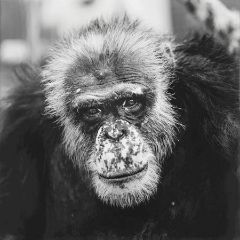TOM

1959–2009
”Meeting Tom for the first time, my first reaction was one of deep sadness. Tom was such a great energy, physically and emotionally enormous… he was so wise, so sad, so in need of love, and desperately wanting to give love. Tom was in the wrong place, the life he should have had in the wild, was stollen from him. To say that Tom reminded me of the greatest gorilla in the world, King Kong, would not be inaccurate.” –Gloria Grow
Tom was a remarkable chimpanzee and he is still remembered for his role in the fight to end chimpanzee research. He was an important ambassador for the NEAVS Release and Restitution campaign. Tom was, and still is, an ambassador for all chimpanzees in captivity. His story continues to be told and will live on until the last chimpanzee is out of research, living safely in Sanctuary.
Tom was born in Africa, taken from his mother, his family, and his home. His freedom was forever stolen from him. When he was shipped to America he was sold to a zoo, where he spent the first years of his life. I learned this from a man who reached out to me after reading about Tom and all the things he did. After speaking together and listening to what he had to say, I was sure it was Tom he had known as a young chimpanzee. This fellow never knew where Tom went after the zoo, but what he said made a lot of sense. Back in those days young males who caused problems were quickly removed from zoos and sold to the research community. That was Tom’s fate.
I don’t know the exact date Tom entered research hell, but I do know The Buckshire Corporation owned him. They had more than one location and Tom spent time in both the New Mexico Division (White Sands, Alamagordo, NM) and the Pennsylvania location. He was approximately 15 years old when he was sold along with six other chimpanzees: Magoo, Susie, Jo Bananas, David, Nancy, and Becky. They were shipped by truck on July 30, 1982 and on August 13, Tom, Susie and Magoo arrived at LEMSIP, the Laboratory for Experimental Medicine and Surgery in Primates. There was no record of any of the others found in the LEMSIP files. What a sad and horrible journey that must have been, and sadly, one that so many chimpanzees have taken over the years.
Tom would spend another 15 years locked in a very different kind of cage. He was infected with the HIV virus in the hopes he would develop AIDS, his life sacrificed for research the good of humankind. It was assumed he would die of AIDS. He did not.
Tom endured the unimaginable. He witnessed the most violent acts against his cellmates. Imagine for one moment what it must be like to be alone in a cage and see three or four men enter the room, all dressed in white, their faces covered with plastic visors, their arms, legs, hands and feet completely covered up, carrying guns and needles? Frightening. Now imagine those very same people arriving in front of a cage and calling your name; the fear that must race through a mind. This is what Tom would witness, daily, weekly and monthly, year after year, after year.
He would see his friends shot with dart guns and he would try to respond to their calls for help, to offer them reassurance from his cage, unable to touch them or reach them in any way. He witnessed them drop to the floor of their cages, screaming, still looking to him for help. Then he would watch as the life slowly slipped from them and they lay perfectly still. It would appear as if they had just died.
The door would be opened and their bodies poked for signs of consciousness, and then the men would drag Tom’s friend out of the cage. The body would be dropped onto a wagon and rolled into the hallway where, from his cage, he could see them stick long needles into them. These were often liver punch biopsies. There were other procedures that would be done, all within his view. Or, his friend might just be wheeled away to the surgical unit.
On many occasions his fellow chimpanzees did not return. Some died and never came back, others were transferred and never seen again. But perhaps, on summer days, while the doors were open, Tom might have heard the calls of an old friend? Though he would never have the chance to see them again.
Not only did Tom have to witness these acts of cruelty in the name of science for most of his life, he also had to endure them. He would be darted and knocked down (to be put under anesthesia) hundreds of times in his years in research. Most chimpanzees at that time were used very heavily because so few were readily available. There were no babies being born in laboratories in the early years. The infants would come later, part of the surplus of chimpanzees in labs and a national embarrassment. In America today there are still far too many chimpanzees stuck in research labs and not enough money to get them out or to care for them. All the billions of dollars that were made through “using” them, and not a cent put aside to retire them and care for them after their “service” is over.
While Tom was in research, he would be subjected to weekly darts, knockdowns, and procedures. He would eventually grow tired of the treatment, the loss of trust and compassion, and become angry. He grew weary and bitter and did not trust people. Understandably, he became more and more difficult, using his willpower to make life difficult for the technicians who tried to get him to cooperate.
Tom had no reason to trust and no one to feel close too. Each and every person in the research lab who befriended him would eventually be asked to betray him. They would use their friendship to coax a chimpanzee into a corner or to offer their arm for a needle. In the lab the chimpanzees will often become attached to anyone who seems nice to them, anyone who does something considerate, or generous. They have nothing else and they are at the mercy of the humans who dump the chow into their feed boxes or pour water into their drinking vessels. Those humans in white suits with their fruits and vegetables are as good as God.
Imagine what it must be like when you have to be nice in order to receive food? That is how it works. If a chimpanzee behaves, they get something. If they are really nice they get more. If they act out; grab, spit or throw feces, one can only wonder what a chimpanzee behind bars might get in return.
I think the majority of people believe that animals in research laboratories should be treated humanely; most people expect that. They also believe that research animals are treated well. After all, they are being sacrificed for us. The expectation is that the basics — food, water and a bed — are offered without expectations. However, it has been shown over and over again that these things are not always being done and there is an exchange that is forced upon them. They must give something in order to get anything.
To me this is one of the cruelest tortures: deprivation and having to negotiate for food or water. What right does anyone have to deprive them of this? They are locked in small cages and have no way of getting out to get things on their own. They are owned by multi-billion dollar corporations and being used as test subjects for some of the wealthiest organizations in the world, and yet, they cannot make sure that these research subjects are properly cared for and that their most basic needs are offered freely. It is so wrong and it all needs to end. Doctors, pharmacists, researchers and scientists — some of the most intelligent people in our community know of these atrocities and do nothing to stop it — professionals who should know better.
So Tom just got tired of it all and when we met him he was done with them, with the negotiating. After years of having to absorb all those drugs he was very resistant and it took so much more to put him under anesthesia. Each time he was used it took a further toll on his body.
I was there at the lab once when four men tossed this dear old fellow into his steel cage. As he was waking up from his anesthesia after his vasectomy, watching his body thrash around on the cold filthy floor of the cage, seeing him desperately try to climb and get away, pulling on the chains that held up the tire that was his bed, it was almost more than I could bear. But worse still, that I was the only one who saw how horrible this was. Everyone around me was so desensitized to all of it. This is what happens to people who must do these things day after day. Just like those who slaughter farm animals, slitting throats with no remorse, no feeling, and their sensitivity deadened.
Tom went through hell…his body never recovered but his mind and his soul were given a new life when he moved to sanctuary. Tom embraced it with every fiber of his being. He found a loving, caring friendship with a special human, and most importantly, deep and lasting love with his chimpanzee family.
Tom was a stately fellow — so present, so alive, so aware, and vocal. He knew whom he liked, knew what he wanted and was very clear. He changed the way we did everything. He led a group of young males into their adolescence with rules and boundaries, each one of them growing wiser and more secure each day they spent with Tom.
Tom protected and supported friends his own age. He lived with some of the most damaged of chimpanzees, troubled and worn out from their years behind bars. Yet, he always found ways to nurture his friends. Tom looked after Donna Rae, Yoko, Pablo, and even Jeannie. He had a second chance when he got out. Sanctuary life saved him, helped him recover, and taught him to trust again. Tom was remarkable.
With our last breath we must speak out for these special souls locked up in research institutions. We must question the researchers, technicians or veterinarians who work in laboratories when they continue to tell us they “care” about their subjects. If they cared about these “subjects” they would not do what they are doing to them. They would do everything possible to get them out, expose the cruelties, or leave and just not participate anymore. If no one did this work, then it would not be able to go on. If all animal technicians who work in research labs said they would not do it anymore, it would have to stop. It all rests in the hands of a small number of people who have the power to end it all if they wanted to. If they stopped convincing themselves that they are there for the animals, that the animals need them, or that the research needs to be done to save human lives. It has been proven over and over that this is not the case. It should no longer be questioned — it is not acceptable to hurt another living being.
“The awesome joy of accepting one’s inclusion in the divine plan is no way nullified by discovering that many priestly scholars are manipulative savages.” —John Kaminski.





